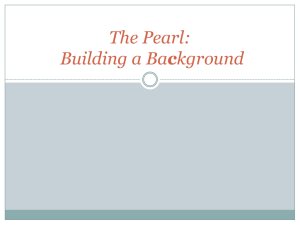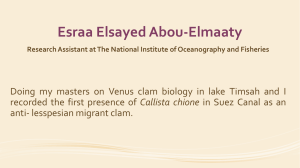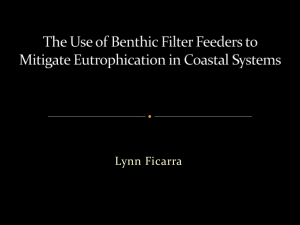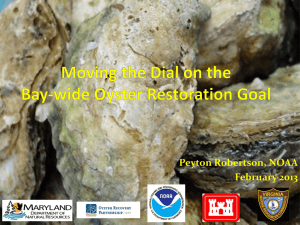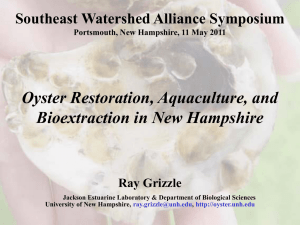4-28-11 - Repositories
advertisement
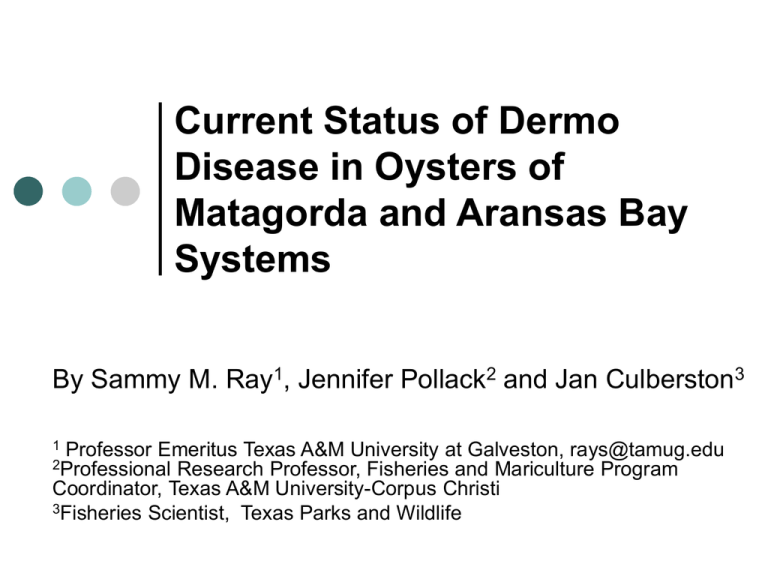
Current Status of Dermo Disease in Oysters of Matagorda and Aransas Bay Systems By Sammy M. Ray1, Jennifer Pollack2 and Jan Culberston3 1 Professor Emeritus Texas A&M University at Galveston, rays@tamug.edu 2Professional Research Professor, Fisheries and Mariculture Program Coordinator, Texas A&M University-Corpus Christi 3Fisheries Scientist, Texas Parks and Wildlife Oyster Reef Restoration There is a great interest in restoration of oyster reefs in the Gulf of Mexico as a result of destruction brought on by three major hurricanes (Katrina, Rita, Ike) and the more recent BP oil spill Recent reports suggest that oysters are disappearing worldwide except the Gulf of Mexico In most places throughout the world oyster populations are less than 10% of there former levels And in many areas natural recruitment is so poor that hatchery production is relied upon to provide recruitment for oyster reef restoration and commercial production The worlds one bright spot for oysters has been dimmed by the BP oil spill and the ill conceived fresh water diversion from the Mississippi river that decimated oyster populations along the Louisiana coast Other than the aforementioned natural and man-made disasters being responsible for oyster disappearances, “over fishing and pollution” are the most often cited causes of this marked decline Except for areas like the East Coast of North America, seldom mention is made of diseases and predation as significant contributors to this decline The purpose of this presentation is to highlight the role of these factors as headwinds to the restoration of oyster reefs in the Gulf of Mexico Oyster Drill Stramonita (Thais) haemastoma Oyster Drill Egg Cases, Galveston Bay Oyster Drill Currently there is little information on the population density and damage caused by the Southern oyster drill Oyster fisherman reported heavy damages from this predator in Galveston Bay in 2010 This predator is appearing in unexpected abundances in January and February of 2011 The early appearance of this predatory snail in winter bodes ill for the oyster recruitment and production in the spring and summer of 2011 Drill populations are generally reduced by salinities below 15 ppt and low temperatures Due to the colder than usual winter of 2010 and thus far in 2011 I am surprised at the levels of drill populations It is my opinion, without data to support it, that the recent widening and deepening of the Houston Ship Channel is providing a vast refuge for drills, where they can escape the deleterious low salinity caused by floods One approach to control may be introducing the predatory snails as specialty seafood items Pilot studies by a local seafood provider in this regard are being conducted with oyster drills as Biganos The utilization of animals as food is a well known method of population control This method is also being suggested for the control of cow nose rays (an oyster predator) on the East Coast. Perkinsus marinus (Dermo) Responsible for millions of dollars in loss of the eastern oyster on the East and Gulf Coast Much effort with little results has been expended towards developing a genetically engineered oyster that is resistant to dermo Thus far the only successful remedy is through the reduction of salinity by adequate freshwater inflow For twenty years or more Dr. Thomas Soniat and I, with the cooperation of the Texas Department of Parks and Wildlife, and The Coastal Management Program of the Texas General Land Office have monitored the dermo levels in the major oyster reefs of Texas bays We also have limited coverage of dermo levels in major oyster producing areas throughout the Gulf of Mexico One of the sites proposed for a major restoration of oyster reefs is Matagorda Bay, Texas I have a concern about the selection of this site because of increases in dermo in the area beginning in late summer and continuing through the winter Mackin’s 5 point system of weighting Dermo infection intensity (weighted prevalence) in live oysters 0.00-0.99 Green 1.00-1.99 Yellow 2.00+ Red - Generally oysters accumulate heavier infections of dermo as they age - Recently, I discovered moderately heavy infections in small oysters (1-1.5 inch length) in December from Aransas Bay, Texas - In high salinity bays oysters survive dermo disease better in the intertidal zone than subtidally - During long droughts market oysters practically disappear sub-tidally with the subsequent invasion of the horse oyster (Ostera equestris) Cultured gill x80 Oyster Sentinel Oyster Sentinel is a web-based community which uses the eastern oyster, Crassostrea virginica, as a bioindicator of estuarine health. Oysters are sessile filter feeders which concentrate toxins, accumulate pathogens and harbor parasites. The distribution of oysters and their parasites are practical indicators of salinity regimes in estuaries. (oystersentinel.com 2011) Half moon Reef Half Moon Reef Changes wrought by building of dams, waterways, pipeline corridors, flood and erosion control projects, etc. in most cases have reduced and/or changed the timing of freshwater flows into estuaries Man’s alteration of the environment resulted in average increases in bay salinities which in turn exacerbates the ravages of oyster enemies The philosophy of providing undisturbed sanctuaries to restore oyster reefs to their former productivity may be misleading Such approach permits the accumulation of silt along with reef subsidence which often occurs that may render the substrate unsuitable for spat set This condition can be alleviated by working reefs with dredges sans the netting to loosen the silt and turn over the substrate and oysters (rolling oysters) The periodic removal of oysters for the market may reduce the reservoir of disease organisms The infective dermo cells survive decomposition in dead tissue and the digestive processes when devoured by scavengers Current restoration goals appear to be based on yesterday’s rather than today’s conditions Sammy’s Reef (2010-2011) Date Collected T S Juvenile Infection Percent Infection Commercial Infection Infection Intensity Weighted Prevalence Percent Infection Infection Intensity Weighted Prevalence 1/19/2011 12.6 23.8 80 1.5 1.2 12/13/2010 11.1 23.7 80 2.29 1.83 11/9/2010 19.2 24.9 43.8 0.9 0.4 100 1.93 1.93 10/19/2010 25.7 20 21.4 1.67 0.36 92.3 1.78 1.64 9/21/2010 26.4 26 40 1.83 0.73 100 2.73 2.73 8/17/2010 31.4 25 25 1.34 0.33 88.9 2.38 2.11 7/20/2010 30.3 17.6 100 1.77 1.77 6/23/2010 31.2 25 70 2.48 1.73 5/26/2010 27.2 25.1 70 2.14 1.5 4/19/2010 21.9 29 60 1.67 1 84.6 1.76 1.49 3/16/2010 18.1 18 12.5 0.67 0.08 30 0.67 0.2 2/17/2010 10.8 20.4 30 0.33 0.1 10 0.33 0.03 1/20/2010 15.7 9.9 60 0.61 0.37 Mad Island Reef (2010-2011) Date Collected T Juvenile Infection S Commercial Infection Percent Infection Weighted Percent Infection Weighted Infection Intensity Prevalence Infection Intensity Prevalence 3/24/2011 23.5 30 90 2.15 1.93 2/22/2011 19.7 21.7 80 0.84 0.67 1/19/2011 12.6 23.8 80 1.5 1.2 12/13/2010 11.1 23.7 80 2.29 1.83 11/9/2010 19.2 24.9 43.8 0.9 0.4 100 1.93 1.93 10/19/2010 25.7 20 21.4 1.67 0.36 92.3 1.78 1.64 9/21/2010 26.4 26 40 1.83 0.73 100 2.73 2.73 8/17/2010 31.4 25 25 1.34 0.33 88.9 2.38 2.11 7/20/2010 30.3 17.6 100 1.77 1.77 6/23/2010 31.2 25 70 2.48 1.73 5/26/2010 27.2 25.1 70 2.14 1.5 4/19/2010 21.9 29 60 1.67 1 84.6 1.76 1.49 3/16/2010 18.1 18 12.5 0.67 0.08 30 0.67 0.2 2/17/2010 10.8 20.4 30 0.33 0.1 10 0.33 0.03 1/20/2010 15.7 9.9 60 0.61 0.37 Shell Island Reef 2010-2011 Date Collected T Juvenile Infection S Commercial Infection Percent Infection Weighted Percent Infection Weighted Infection Intensity Prevalence Infection Intensity Prevalence 3/24/2011 23.8 30 100 1.73 1.73 2/22/2011 20.3 19.7 90 1.19 1.07 1/19/2011 13.4 23 100 1.13 1.13 12/13/2010 10.8 20.2 90 1.37 1.23 11/9/2010 20.1 23 16.7 1.34 0.22 100 1.7 1.7 10/19/2010 25.5 17 71.4 0.93 0.67 90 2.04 1.83 9/21/2010 26.7 25 90 3.19 2.87 8/17/2010 31 24 80 2.58 2.07 7/20/2010 30.1 15.2 90 2.3 2.07 6/23/2010 31.1 24 70 1.76 1.23 5/26/2010 27.3 25.1 100 1.83 1.83 70 2.38 1.67 4/19/2010 21.8 26.5 33.3 0.5 0.17 78.6 1.61 1.26 3/16/2010 18.4 17.6 10 0.33 0.03 0 0 0 2/17/2010 9.9 12.8 20 0.33 0.07 40 0.33 0.13 1/20/2010 16.5 2.3 20 0.5 0.1 50 2.67 1.33 Oyster Lake 3-14-11 Temp Salinity 20.6 26.4 Weighted Prevalence Prevalence 90 1.54 Freshwater inflow Aransas/Copano Bays Station Date Collected T Juvenile Infection S Commercial Infection Percent Infection Weighted Percent Infection Weighted Infection Intensity Prevalence Infection Intensity Prevalence Lap Reef 12/16/2010 16.7 8.5 10 0.33 0.03 20 1 0.2 Shell Bank Reef 12/16/2010 15.9 6.9 0 0 0 0 0 0 SW Causeway Reef 12/16/2010 16.9 10 70 1.57 1.1 70 1.14 0.8 Grass Islands Reef 12/16/2010 15.8 10 50 0.47 0.23 60 1.78 1.07 Half-Moon Reef 12/16/2010 15.4 12 40 0.83 0.33 20 0.33 0.07 NW Causeway Reef 12/16/2010 16.3 9.3 50 1.8 0.9 Long Reef 12/16/2010 16.2 12.4 90 1.93 1.73 100 1.67 1.67 Grass Islands Reef 4/12/2011 23.5 21.5 70 1.09 0.77 90 1.78 1.6 Half-Moon Reef 4/12/2011 23.1 24.4 40 1.25 0.5 40 1.41 0.57 Long Reef 4/12/2011 22.5 25.7 90 2.15 1.93 90 2 1.8 NW Causeway Reef 4/12/2011 25.4 19.5 90.9 1.7 1.55 90 1.56 1.4 Discussion As a conclusion: It is my opinion that disregarding the potential damage by diseases and predators to oyster reef restoration is a mistake It is my opinion with the prospects of climate change and sea level rise that care should be taken in selecting restoration sites and efforts should be made to select sites nearest fresh water inflow to reduce the adverse effect of high salinities in promoting oyster enemies. In a recent report there was the prediction that the sea level would rise up to 3 feet along the Eastern and Gulf Shores within the next 90+ years When choosing potential reef sites go towards the freshwater In keeping with my interest in hunting, I think of salinity and temperature conditions for best oyster culture in terms of rifle caliber 20-20 is good, 30-30 is bad Acknowledgments Perley G. and Kathreen Parr Gift Account for financial support Texas Parks and Wildlife for providing oysters from Matagorda Bay Rachel Dean (Lousby, Maryland) for providing oysters from Maryland Elizabeth Silvy for technical assistance



